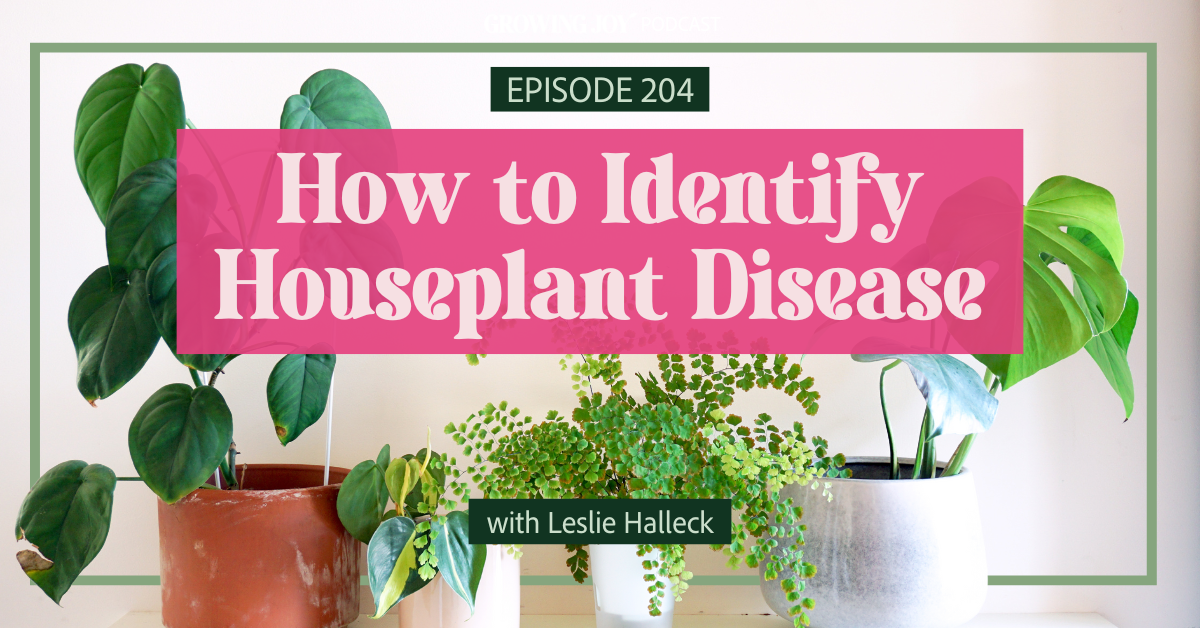Plant Parenting: How to Identify Houseplant Diseases
September 19, 2023
Is your houseplant suddenly dropping leaves, getting spots, or just looking sick?
Plant diseases can strike fear into any plant parent's heart. One day your plant baby is thriving, and the next it's on the decline! Here are the highlights from my third episode in the "Grow Better with Leslie" Series on Maria Failla's "Growing Joy with Plants" Podcast.
Plant diseases happen to the best of us. Even expert growers deal with fungal, bacterial, and viral plant infections. The good news is that many common houseplant diseases are treatable if caught early. But plant friends, you need to first know how to accurately identify them.
In the third episode of the Grow Better series with my dear friend, Leslie Halleck, we explore how to spot symptoms, diagnose plant illnesses, build a first aid kit, and nurse your plants back to health.
What Factors Cause Diseases in Houseplants?
It’s important to understand what causes plant diseases in the first place. According to Leslie, there are three key elements required for a plant to contract an illness, known as the “disease triangle:”
A susceptible host plant
Pathogens such as fungi, viruses, or bacteria
Environmental conditions
The pathogens must come into contact with and enter the plant, then establish themselves and reproduce. Stressed plants are more prone to pathogens taking hold.
Common Plant Pathogens
There are different types of pathogens that can cause disease symptoms in plants. Here are the most common pathogens that can affect our plants:
Fungal diseases - These include issues like powdery mildew, leaf spot, and root rot. Fungi reproduce via spores and mycelium (threadlike growths).
Viral diseases - Viruses cause mosaic patterns, stunted growth, and deformed leaves/tissues. They are incurable and often fatal.
Bacterial diseases - Bacteria create water-soaked angular lesions on leaves and stems. They thrive in humid conditions.
Nematodes - Microscopic roundworms that infect plant roots. These are more common in outdoor plants than in houseplants.
Abiotic stresses - Environmental factors like improper light, water, etc. can also create “disease” symptoms.
Common Symptoms of Sick Plants
Indications that a plant might be sick include leaves turning yellow or a different color, spots or sores on leaves and stems, the plant looking floppy or droopy, losing its leaves, not growing as much as it should, and its leaves looking twisted or bent.
Note: Signs are physical evidence of the pathogen itself, such as fungal spores on leaves. On the other hand, symptoms are the plant's reactions, like wilting leaves or yellow spots.
While helpful, symptoms alone are unreliable for diagnosis. You need to consider the full picture:
What are the environmental conditions like? High humidity?
Does the species have known disease susceptibilities?
Can you see any signs like fungal spores under a magnifying glass?
When in doubt, Leslie encourages you to isolate the plant from others to prevent spreading. Scout all your plants frequently and address issues early.
General Disease Treatment Guidelines
Accurate diagnosis is key before treating plant diseases; otherwise, you may do more harm than good! Here are some basic guidelines:
Fungal diseases - Use fungicides specifically labeled for the plant/disease. Improve air circulation.
Viral diseases - Destroy infected plants to prevent spreading. Sterilize any tools used on sick plants.
Bacterial diseases - Apply bactericides suited to the plant. Reduce water on leaves.
Treating Specific Houseplant Diseases
Now let’s go over some of the most common houseplant diseases and how to treat them:
Powdery Mildew
Caused by overhead misting and high humidity. Signs are white powdery coating on leaves and stems. Treat with fungicides and remove affected parts.
Leaf Spot
Various fungal/bacterial species cause spots that grow/spread. Remove infected leaves promptly. Apply effective fungicide.
Root Rot
Multiple fungi cause brown, slimy roots. Repot in sterile soil and use a fungicide drench.
Molds
Molds show up as faint gray stuff on leaves or soil and grow in overly wet conditions. Wipe off, increase airflow, and treat with fungicides.
Viral Diseases
Viral Diseases make plants look strange with mosaic patterns and they don't grow well. Sadly, there's no medicine for this. The best thing to do is to get rid of the sick plants and clean your tools carefully to stop it from spreading.
When to Get Rid of a Sick Plant
Sometimes plant diseases can’t be cured, especially viruses and severe fungal infections. Other times, the infection has progressed too far to save the plant.
The hard truth is that you can’t save every plant. If a plant is too far gone, it’s better to remove it so the disease doesn’t spread! Consider taking healthy cuttings to propagate a new plant.
Rely on Research-Based Resources
With so much misinformation online, it’s important to get your plant care advice from science-backed sources. Here are some reliable educational resources:
Local university agricultural extension services - Many will diagnose diseases if you submit plant samples.
Horticulture books specifically about plant diseases - Look for titles by respected authors.
University studies - Search online using terms like “research” or “publication.”
When it comes to plant health, knowledge truly is power. Learning how to properly identify, treat, and prevent common houseplant diseases will give you the confidence to handle any issue. Pay close attention to your plants, act quickly when needed, and you’ll be rewarded with thriving plants!
You can listen to the podcast episode HERE for all the details from Leslie!


